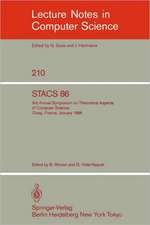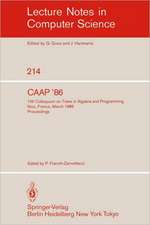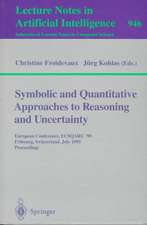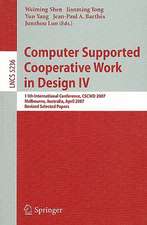Human Machine Interaction: Research Results of the MMI Program: Lecture Notes in Computer Science, cartea 5440
Editat de Denis Lalanne, Juerg Kohlasen Limba Engleză Paperback – 26 mar 2009
These projects were also partially funded by the associated universities and other third parties such as the Swiss National Science Foundation.
This state-of-the-art survey begins with three chapters giving overviews of the domains of multimodal user interfaces, interactive visualization, and mixed reality. These are followed by eight chapters presenting the results of the projects, grouped according to the three aforementioned themes.
Din seria Lecture Notes in Computer Science
- 20%
 Preț: 1061.55 lei
Preț: 1061.55 lei - 20%
 Preț: 307.71 lei
Preț: 307.71 lei - 20%
 Preț: 438.69 lei
Preț: 438.69 lei - 20%
 Preț: 579.30 lei
Preț: 579.30 lei -
 Preț: 410.88 lei
Preț: 410.88 lei - 17%
 Preț: 427.22 lei
Preț: 427.22 lei - 20%
 Preț: 596.46 lei
Preț: 596.46 lei - 15%
 Preț: 448.04 lei
Preț: 448.04 lei - 20%
 Preț: 353.50 lei
Preț: 353.50 lei -
 Preț: 389.49 lei
Preț: 389.49 lei - 20%
 Preț: 309.90 lei
Preț: 309.90 lei - 20%
 Preț: 645.28 lei
Preț: 645.28 lei - 20%
 Preț: 763.23 lei
Preț: 763.23 lei - 15%
 Preț: 580.46 lei
Preț: 580.46 lei - 20%
 Preț: 310.28 lei
Preț: 310.28 lei - 20%
 Preț: 655.02 lei
Preț: 655.02 lei - 20%
 Preț: 1183.14 lei
Preț: 1183.14 lei - 20%
 Preț: 340.32 lei
Preț: 340.32 lei -
 Preț: 449.57 lei
Preț: 449.57 lei - 20%
 Preț: 591.51 lei
Preț: 591.51 lei - 18%
 Preț: 938.83 lei
Preț: 938.83 lei - 20%
 Preț: 337.00 lei
Preț: 337.00 lei - 20%
 Preț: 649.50 lei
Preț: 649.50 lei - 20%
 Preț: 607.40 lei
Preț: 607.40 lei - 20%
 Preț: 1414.79 lei
Preț: 1414.79 lei - 20%
 Preț: 1024.44 lei
Preț: 1024.44 lei - 20%
 Preț: 583.40 lei
Preț: 583.40 lei - 20%
 Preț: 453.32 lei
Preț: 453.32 lei - 20%
 Preț: 575.49 lei
Preț: 575.49 lei - 20%
 Preț: 1075.26 lei
Preț: 1075.26 lei - 20%
 Preț: 585.88 lei
Preț: 585.88 lei - 20%
 Preț: 825.93 lei
Preț: 825.93 lei - 17%
 Preț: 360.20 lei
Preț: 360.20 lei - 20%
 Preț: 763.23 lei
Preț: 763.23 lei - 20%
 Preț: 340.32 lei
Preț: 340.32 lei - 20%
 Preț: 504.58 lei
Preț: 504.58 lei - 20%
 Preț: 369.13 lei
Preț: 369.13 lei - 20%
 Preț: 580.93 lei
Preț: 580.93 lei - 20%
 Preț: 343.62 lei
Preț: 343.62 lei - 20%
 Preț: 350.21 lei
Preț: 350.21 lei - 20%
 Preț: 583.40 lei
Preț: 583.40 lei - 20%
 Preț: 583.40 lei
Preț: 583.40 lei - 15%
 Preț: 438.59 lei
Preț: 438.59 lei - 20%
 Preț: 341.95 lei
Preț: 341.95 lei - 20%
 Preț: 238.01 lei
Preț: 238.01 lei - 20%
 Preț: 538.30 lei
Preț: 538.30 lei
Preț: 333.88 lei
Preț vechi: 417.34 lei
-20% Nou
Puncte Express: 501
Preț estimativ în valută:
63.88€ • 66.71$ • 52.76£
63.88€ • 66.71$ • 52.76£
Carte tipărită la comandă
Livrare economică 16-30 aprilie
Preluare comenzi: 021 569.72.76
Specificații
ISBN-13: 9783642004360
ISBN-10: 3642004369
Pagini: 332
Ilustrații: XIV, 311 p.
Dimensiuni: 155 x 235 x 15 mm
Greutate: 0.46 kg
Ediția:2009
Editura: Springer Berlin, Heidelberg
Colecția Springer
Seriile Lecture Notes in Computer Science, Programming and Software Engineering
Locul publicării:Berlin, Heidelberg, Germany
ISBN-10: 3642004369
Pagini: 332
Ilustrații: XIV, 311 p.
Dimensiuni: 155 x 235 x 15 mm
Greutate: 0.46 kg
Ediția:2009
Editura: Springer Berlin, Heidelberg
Colecția Springer
Seriile Lecture Notes in Computer Science, Programming and Software Engineering
Locul publicării:Berlin, Heidelberg, Germany
Public țintă
ResearchCuprins
Human Machine Interaction.- Multimodal Interfaces: A Survey of Principles, Models and Frameworks.- Interactive Visualization - A Survey.- Mixed Reality: A Survey.- Multimodal User Interfaces.- Intelligent Multi-modal Interfaces for Mobile Applications in Hostile Environment(IM-HOST).- MEMODULES as Tangible Shortcuts to Multimedia Information.- Why Androids Will Have Emotions: Constructing Human-Like Actors and Communicators Based on Exact Sciences of the Mind.- Interactive Visualization.- EvoSpaces - Multi-dimensional Navigation Spaces for Software Evolution.- HOVISSE – Haptic Osteosynthesis Virtual Intra-operative Surgery Support Environment.- A Language and a Methodology for Prototyping User Interfaces for Control Systems.- Mixed Reality.- See ColOr: Seeing Colours with an Orchestra.- 6 th Sense– Toward a Generic Framework for End-to-End Adaptive Wearable Augmented Reality.
Recenzii
From the reviews:“The Hasler Foundation of Switzerland funded a research program that focused on specific subdomains of human-machine interaction … . This book presents the results of the program’s eight projects. … Overall, the research projects described in the book have produced innovative techniques and technologies that could support humans in important application domains, such as the inclusion of blind people in society. This book well structured and includes illustrations. It could be very useful to readers who are interested in current human-machine interaction research.” (George K. Adam, ACM Computing Reviews, January, 2010)
Textul de pe ultima copertă
Human Machine Interaction, or more commonly Human Computer Interaction, is the study of interaction between people and computers. It is an interdisciplinary field, connecting computer science with many other disciplines such as psychology, sociology and the arts.
The present volume documents the results of the MMI research program on Human Machine Interaction involving 8 projects (selected from a total of 80 proposals) funded by the Hasler Foundation between 2005 and 2008.
These projects were also partially funded by the associated universities and other third parties such as the Swiss National Science Foundation.
This state-of-the-art survey begins with three chapters giving overviews of the domains of multimodal user interfaces, interactive visualization, and mixed reality. These are followed by eight chapters presenting the results of the projects, grouped according to the three aforementioned themes.
The present volume documents the results of the MMI research program on Human Machine Interaction involving 8 projects (selected from a total of 80 proposals) funded by the Hasler Foundation between 2005 and 2008.
These projects were also partially funded by the associated universities and other third parties such as the Swiss National Science Foundation.
This state-of-the-art survey begins with three chapters giving overviews of the domains of multimodal user interfaces, interactive visualization, and mixed reality. These are followed by eight chapters presenting the results of the projects, grouped according to the three aforementioned themes.




























